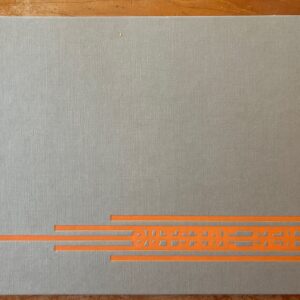JTF (just the facts): A total of 31 black and white photographs, framed in black and matted, and hung against white walls (including one hanging divider) in the main gallery space. The images were taken between 1985 and 2008 and come from a selection of projects: Townships, Train Church, Rumours: The Bloemhof Portfolio, Chasing Shadows, Landscapes of Trauma, and Climate Change. In the smaller side room, a slideshow of images/texts from The Black Photo Album/Look at Me: 1890-1950 is on display. A monograph of this particular body of work was published by The Walther Collection/Steidl in 2013 (here). An introductory essay by Joshua Chuang is provided in the gallery checklist. (Installation shots below.)
Comments/Context: The other day, I had a conversation with a London-based photography writer, sharing notes on trends we were seeing in contemporary photography. She asked me about some area of recent activity and out of my mouth popped something about part of the problem in characterizing these trends being that we suffer from a form of selection bias – we are at the mercy of what we have seen, and may not be aware of other better, more important, or otherwise relevant work that hasn’t been shown recently (or ever) in New York (or London or wherever). This passing insight hit me again while walking around the excellent Santu Mofokeng survey show on view at the Walther Collection. The history of South African photography has been punctuated by colonial-era ethnographic documentation and apartheid-regime resistance imagery, and so we might logically think that this is what South African photography is, based on the limited sample that we’ve been exposed to. But of course, this easy assumption misrepresents the more complicated reality. Mofokeng’s photographs don’t fit this rigid intellectual mold – there are no violent emotions or angry riots in his images. His everyday dramas are much more subtle and complex, but no less compelling or powerful.
The photographer’s mid 1980s images of life in the townships are full of incongruities, the kinds of observations that might have been framed as tragedy or bleak comedy by another artist, but which have been left unassumingly open-ended by Mofokeng. Boys scour the scrubland looking for their lost golf balls, a white stallion stands amid the muddy squalor of a firewood lot, and a man peers over a fence at a soccer game being played in the dust. The pictures are sensitively indirect and quietly resilient, documenting a makeshift, improvised life of dancing in the kitchen, a chicken in the dirt floor bedroom, and houses propped up by gnarled tree branches, with cemeteries and funeral processions seen just a little too often to be a coincidence. Viewed from the inside, widespread injustices have produced stubbornly human adaptations – the punishing daily commute from Soweto to Johannesburg for work becoming the venue for impromptu religious services, with lively singing, hand clapping, and drumming on the walls of the crowded train cars.
More recently, Mofokeng has turned his camera toward the land, as if trying to come to terms with its resonant mysteries. The most harrowing of these pictures are his images of sites of violence. Cement rectangles, rock piles, aging fences, and clumps of tiny white crosses hide in the weeds of the countryside, obscuring the disappearing sites of mass graves, concentration camps, and murders – history is being overrun by nature, but the land still seems to silently seethe with these scars. Other projects and series capture the mystical spirituality of the Motouleng Cave and the physical manifestations of climate change (white out dust storms, beach erosion, and dam-altered vistas), Mofokeng grappling again and again with the richness of the South African land and the interconnected actions of its people.
The most conceptually challenging work on view is Mofokeng’s subtly disturbing archival slideshow The Black Photo Album/Look at Me: 1890-1950, which is being shown in a darkened side room. In it, he has gathered together a selection of studio portraits of well-dressed black South African sitters (wearing tuxedos and top hats, suits and waistcoats, wedding dresses and tennis whites) and interspersed them with short snippets of background text and provocative questions. In direct contrast to common tribal stereotypes, these pictures point to Western assimilation, indirectly asking fascinating questions about what that might represent. Mofokeng uses the phrase “mental colonization” as a potential answer – it’s a particularly arresting and thoughtful characterization which has stuck with me long after leaving the gallery. It implies a process that included not only the physical disruptions of architecture, infrastructure, and government, but also a more invisible imposition of values, aspirations, and thought systems. Seen this way, the pictures are a richly complicated set of artifacts (who these people were and why did they want to be photographed in this manner?), a testament to the still unraveled contradictions found buried at the core of the country’s history.
The Walther Collection is doing important work in giving a variety of African photographic voices a larger stage, and this sampler show certainly offers a strong alternate perspective to the first level South African dialogue. It bypasses direct documentation of specific violence and oppression, looking deeper and across a wider time scale as actions, reactions, and consequences have rippled across the nation and its people. Mofokeng has taken the long view, sensitively capturing a restlessness of spirit that hasn’t yet found reconciled ease.
Collector’s POV: Santu Mofokeng is represented by Maker Studio in Johannesburg (here). His work has not been widely available in the secondary markets, so gallery retail likely remains the best option for those collectors interested in following up.



















